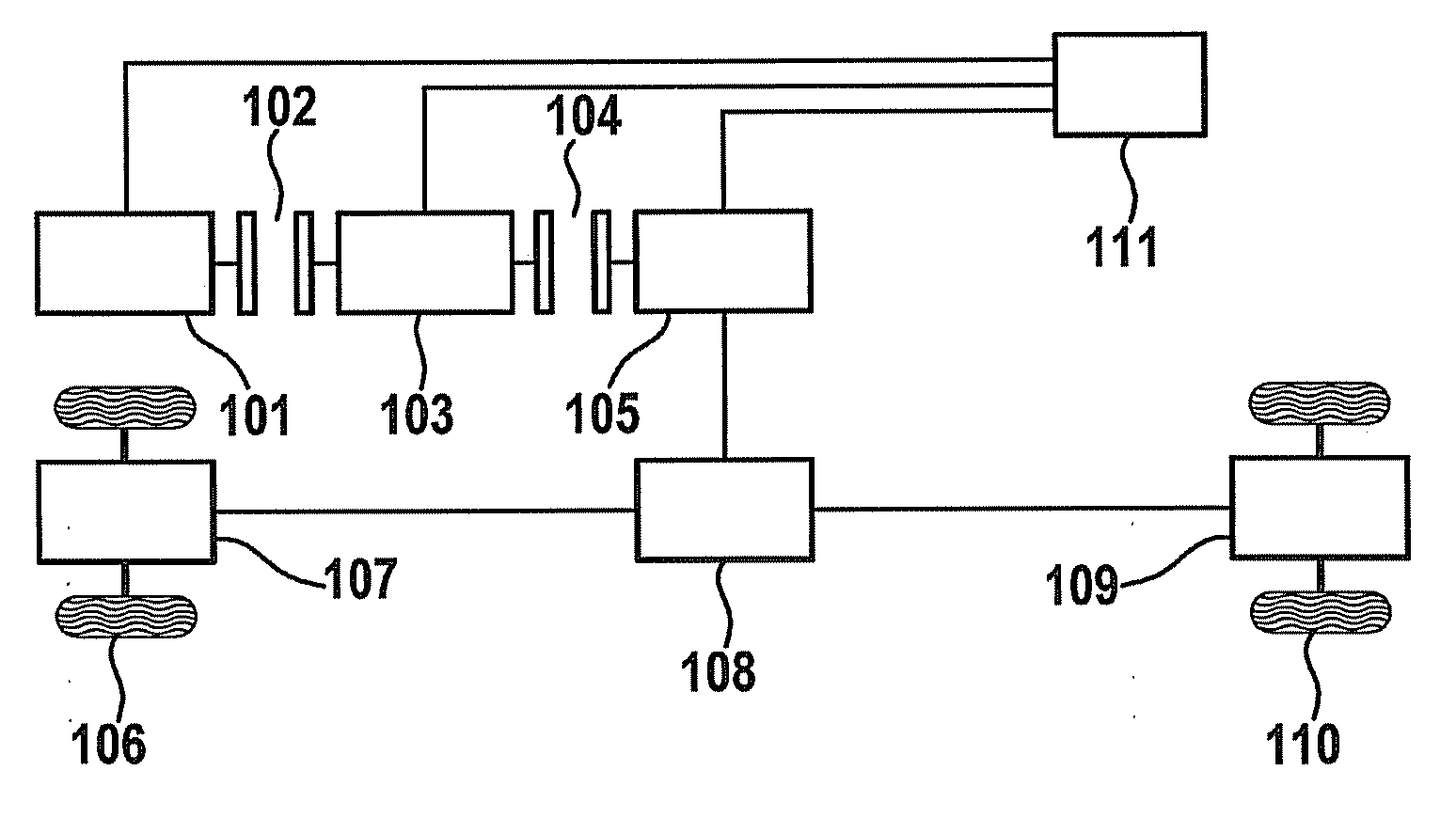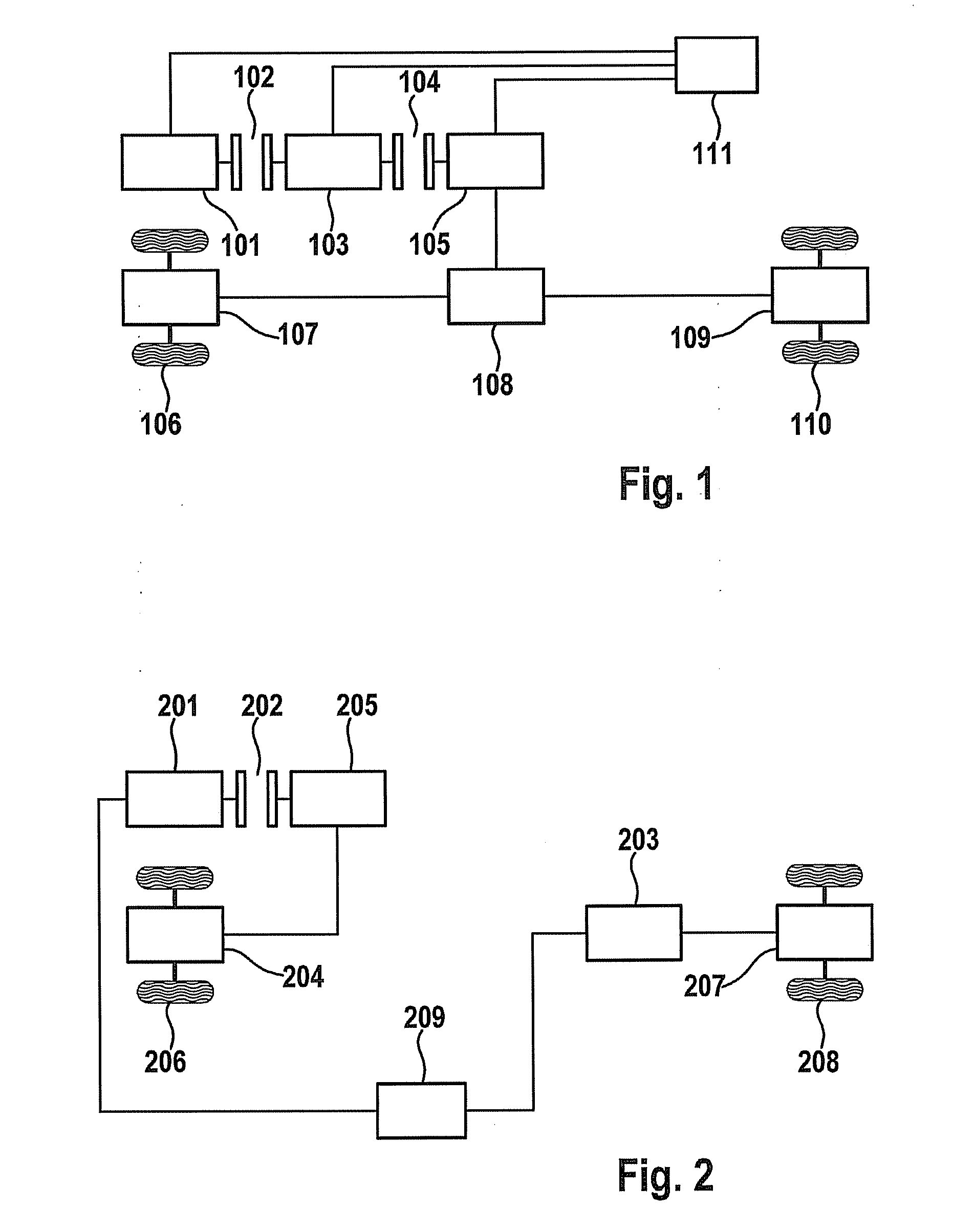[0008]Thus, the method has the
advantage that the torque necessary for starting the non-operating internal
combustion engine is minimized, and a greater proportion of the torque of the additional drive unit may thus be used for the drive of the
hybrid vehicle. Operation in more driving situations is thus possible using the additional drive unit, in particular solely electric driving. This results in increased driving enjoyment and longer distances traveled in which the vehicle is operated using the additional drive unit, in particular in an emission-free manner and in particular at higher driving speeds. Better use is made of the available power of the additional drive unit, in particular the
electric machine, and / or the capacity of the installed
energy storage system (battery, for example). This advantageously results in higher efficiency for the drive with the aid of the additional drive unit. The service life of the clutches and / or the
starter is increased, since these components are used less frequently or are required to do less work when in use. If the
crankshaft of the internal
combustion engine is at a cylinder shutdown angle in which a direct start is expected to fail, the internal combustion engine and the
clutch, in particular the separating
clutch between the internal combustion engine and the additional drive unit, are able to divide up the torque to run up the internal combustion engine; i.e., the
clutch then only needs to transmit a much lower torque than when it used alone to start the internal combustion engine. This torque applied by the additional drive unit, in particular the
electric machine, is no longer available to the vehicle drive. Ideally, before the restart is begun the torque needed by the additional drive unit for starting the internal combustion engine is thus ascertained and kept as a torque reserve. If the internal combustion engine does not accelerate as quickly as expected during a direct start attempt, as an emergency approach the running up of the internal combustion engine may still be assisted (as early as possible) with additional torque by engaging the clutch. As an alternative approach which is less advantageous, the internal combustion engine may attempt a direct start independently of the angular position of the
crankshaft and temperature. The clutch assists, but with a generally smaller torque than would be required for solely starting using the clutch. This additionally accelerates the starting operation and also has a beneficial effect on the startup emissions. Alternatively, the clutch is engaged, at least partially, only temporarily and / or in synchronization with the
crankshaft motion.
[0009]One refinement of the present invention is characterized in that the parameters of the internal combustion engine
system are adjusted in such a way that the internal combustion engine may be started by direct start. The underlying technical background is that torque from the additional drive unit is thus no longer needed for the direct start of the internal combustion engine. The direct start is possible in particular when parameters of the internal combustion engine system are favorable, in particular for a favorable crankshaft angular position of the internal combustion engine, a suitable temperature of the internal combustion engine, and a suitable
injection pressure. This results in the
advantage that the torque necessary for starting the non-operating internal combustion engine is minimized, and therefore the entire available torque of the additional drive unit may be used for the drive of the
hybrid vehicle. In hybrid drives, a drive unit which is necessary for starting the internal combustion engine, in particular a
starter, is relieved with the aid of the direct start, thus allowing a longer service life of the drive unit. The early ignition of the internal combustion engine which is used for the direct start results in improved emissions when the internal combustion engine is started. The possibility of stranded vehicles, in particular vehicles which are no longer drivable due to a breakdown, which may be due to a defective
starter is prevented. If it is determined during a restart attempt that the separating clutch is defective in such a way that it is no longer able to transmit enough torque for starting the internal combustion engine, a solely direct start may be initiated as an emergency approach. The unfavorable emissions which may result in order to avoid a stalled vehicle may be tolerated in this exceptional case. When a direct start fails, the starting operation of the internal combustion engine is assisted in a continuous and / or variable manner by activating the clutch as a function of parameters, in particular the parameters of the internal combustion engine system, in particular using the lowest possible assisting torque. Thus, any available torque which is not needed for starting the internal combustion engine may be used for the propulsion of the vehicle.
[0011]Another refinement of the present invention provides that when it is determined that a direct start of the internal combustion engine is possible, no torque for starting the internal combustion engine is reserved by the additional drive unit. Once again, it is advantageous that the entire torque of the additional drive unit may be used for the propulsion of the vehicle. If, while driving with the aid of the additional drive unit, in particular during electric driving, it is known that the crankshaft of the internal combustion engine is in a favorable crankshaft angular position and the internal combustion engine has a suitable temperature, so that the direct start may be successfully carried out, reserving a torque which is necessary for starting the internal combustion engine, in particular the torque reserve, may be dispensed with, and the
maximum torque of the additional drive unit, in particular the electric
machine, may be used for the propulsion of the vehicle.
[0014]The device according to the present invention for operating a hybrid vehicle, having an internal combustion engine system which has an internal combustion engine and at least one additional drive unit, has means (111, 209) which ascertain the torque necessary for starting non-operating internal combustion engine (101, 201), and this torque is reserved by additional drive unit (103, 203), characterized in that means (111, 209) minimize the torque necessary for starting non-operating internal combustion engine (101, 201) by appropriately adjusting the parameters of the internal combustion engine system. The underlying technical background is that the torque necessary for starting the internal combustion engine is deduced by detecting various parameters of the internal combustion engine system. To be able to utilize as much as possible of the available torque of the second drive unit for the drive, the parameters of the internal combustion engine system are adjusted in such a way that the least possible torque is required for starting the internal combustion engine. The method thus has the
advantage that the torque necessary for starting the non-operating internal combustion engine is minimized, and a greater proportion of the torque of the additional drive unit may thus be used for the drive of the hybrid vehicle.
[0015]In another refinement of the present invention, it is provided that the hybrid vehicle is designed as an axle hybrid, a parallel hybrid, or a
power split hybrid. The underlying technical background of this refinement is that the present invention may be implemented in various
hybrid drive designs. For example, the parameters of the internal combustion engine system are adjusted for minimizing the torque necessary for starting the internal combustion engine in such a way that, for example, by at least partially engaging the clutch the crankshaft of the internal combustion engine may be moved into a position which allows a direct start. In a parallel
hybrid drive and in a
power split hybrid drive, an additional drive unit may be mechanically connected to the crankshaft of the internal combustion engine by engaging the clutch. In an axle hybrid there is no direct mechanical
coupling between an additional drive unit and the crankshaft of the internal combustion engine, but a force may act on the crankshaft of the internal combustion engine when, for a
vehicle driving with the aid of axle hybrid drive, the internal combustion engine is mechanically coupled to the rotating drive axle, for example by engaging a clutch. In the vehicles, in particular vehicles having an axle hybrid drive, components such as a starter,
starter generator, or belt starter, for example, on the internal combustion engine may be dispensed with. In vehicles having an axle hybrid drive, which for example have no additional drive unit, in particular an electric
machine, on the internal combustion engine drive axle, via the direct start with the aid of a slipping starter clutch (and an engaged gear) the internal combustion engine may be started while driving. The starting torques for the internal combustion engine which are necessary for this purpose, as described above, are lower than in the case of a completely started non-operating internal combustion engine. To allow a reliable direct start, the additional drive unit assists the vehicle drive via the other axle. Here as well, the torque additionally required by the additional drive unit must be kept as a torque reserve, and therefore is not
usable in the driving operation with the aid of the additional drive unit. For this purpose, components such as a starter,
starter generator, or belt starter, for example, on the internal combustion engine may be dispensed with.
 Login to View More
Login to View More  Login to View More
Login to View More 


